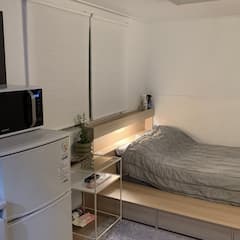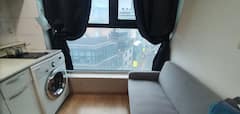Korean cuisine has been receiving much hype lately, along with the hallyu wave (the spread of Korean popular culture and entertainment) that’s been infecting all of Asia and increasingly seeping into the west. Korean cuisine is vast, and it boasts a lot more than just bite-sized spicy rice cakes (ddeokbokki) and mega-sized sushi (kimbap) that you see in your average Korean dramas. Here’s a list of the yummiest (and meanest) Korean delicacies that are definite must-tries when you visit Seoul. From street delicacies and mouth-watering main courses to fancy Korean desserts, we’ve got you covered! Precaution: Try not to drool too much!
Street delights
1. Bindaetteok: mung bean pancake
Stuffed with mung beans, along with kimchi and green onion and crisped to perfection, you can never say no to a slice of bindaetteok. These palm-sized fritters can be found at Gwangjang Market, previously known as Dongdaemun Market. Gwangjang Market is famous for its food alley that boasts an expansive variety of local delights. You’ll see many stalls with towering stacks of golden-brown crispy pancakes that are freshly fried and served piping hot.
2. French fry corn dog

If you love french fries and sausages, you’ll be ecstatic to discover the Korean corn dog. A hot dog coated with French fries, it’s essentially the best of both worlds! Just a bite of its crispy outside topped with ketchup and mustard, depending on how you like it, is enough to get you to fall in love with it. It can be found at most street food stalls; just simply take a walk down Myeong dong and you’ll find these glorious sticks staring at you.
You might be interested in these Airbnbs!
3. Ddeokbokki: spicy rice cake

This flushing orange, two-bite-sized goodness almost needs no introduction. It’s made of soft rice cake, mixed with a sweet and tangy spicy chili sauce called gochujang. In some places, fish cake is added. Ddeokbokki (tteokbokki) can be found almost everywhere from pojangmachas (roadside tents) to street food vendors. It’s one of the dishes that just stands out even if you aren’t looking for it. Alternatively, you can visit Sindang-dong Tteokbokki Town Street, where ddeokbokki is their speciality. The nostalgic alley used to be a place for high school students in the 80s to hang around after school. Though their younger days are over, the now-aged high school students occasionally visit the area to relive their youth. The street is located at Sindang-dong, Jung-gu, Seoul.
How to get there:
1) Sindang Station (Seoul Subway Line 2 or 6), Exit 8.
Go straight until you reach Jungbu Fire Station and turn left.
2) Cheonggu Station (Seoul Subway Line 6), Exit 1.
Turn right when you arrive at the playground and go straight for 200 meters (656 feet).
There will be an arched sign that says “Sindangdong Tteokbokki Town”.
Seoul Tour Guide
연경바람
Discover a vibrant mix of past, present, and future of Korea on a journey you'll never forget. Our tours unlock the secrets of Korean history and culture, offering a profound understanding of the people who make this nation unique. Explore ancient temples, bustling markets, and iconic landmarks, each whispering stories of Korea's fascinating past. Immerse yourself in traditional practices, savor delicious cuisine, and witness the dynamic modern scene. Engage with warm and welcoming Koreans, gaining insights into their lives and perspectives. Share your interests, and we'll tailor a personalized experience that ignites your passion. Join us and create unforgettable memories in Korea. Let us guide you on a journey that will touch your heart and enrich your soul.
Tours by 연경바람
4. Odeng: fish cakes on sticks
Also commonly known as eomuk, odeng is basically fish cakes on wooden sticks that are boiled for hours in a clear, tasty broth. Odeng can be found at almost all street food stalls, and they’re sold by the stick. The vendors will give you a cup with the broth and you can always ask for a refill (and we guarantee you will) – its free of charge! Just eat as many sticks as you’d like and hope the stall lady counts the right number of sticks. Do note that the sticks have to be returned afterwards though!
5. Soon dae: blood sausages

Soon dae may not look very appetizing but it’s definitely a must-try for those who like their food with a chewy texture. It’s made by boiling pigs’ intestines that are stuffed with various ingredients. Some of the commonly added ingredients include cellophane noodles, glutinous rice, pork blood, and squid. It’s a dish people usually eat at a pojangmacha, after work, accompanied with some soju. You can find many pojangmachas in the Jong-no or Hong dae areas.
6. Tornado potato: not your ordinary potato chips

If there’s anything better than potato chips, it’s this. Twisted and sliced with a specialized twister, and then deep fried, tornado potato is finally topped with delicious seasonings like cheese and spices. Each slice is slightly thicker than your usual potato chips, making them crispy on the outside while the thin inner layer is soft and chewy. Overall, it has the right ratio of soft to crispy. When topped with glorious cheese powder, this treat is just irresistible.
More than just a snack
7. Naeng myeon

You may have heard naeng myeon mentioned before. It is a Korean noodle dish, comprising long and thin handmade noodles made from various ingredients, such as buckwheat, potatoes, and sweet potatoes. Naeng myeon is served in a cold and clear broth and topped with sliced Korean pear, pickled radish, and a hard boiled egg. There are many kinds of naeng myeon, and the style of eating it varies from where it originated from. It’s a specialty of Pyongyang (the capital of North Korea).
You can visit Ojangdong Hamheung Naengmyeon, a restaurant that specializes in hamheung naengmyeon (Pyongyang-style chilled buckwheat noodles). Besides Pyongyang naeng myeon, they also have other dishes on their diverse menu, which include wangmandu (large steamed dumplings). Its located at 108, Mareunnae-ro, Jung-gu, Seoul.
How to get there:
Euljiro 4-ga Station (Seoul Subway Line 2, 5), Exit 8.
Go straight for 200 meters (656 feet) and turn left onto Mareunnae-ro Road.
Go straight for 120 meters (394 feet) until you see the restaurant (오장동 함흥냉면) across the street.
8. Jjamppong

If spicy food is your thing, you won’t want to miss a bowl of jjamppong! It sounds really fun to pronounce (and maybe funny to some), but don’t underestimate this bowl of noodles. Boiled in a rich, spicy broth topped with seafood, this Korean-Chinese spicy noodle soup will leave you sweating buckets but craving more! It’s one of the most popular take-out delivery dishes, and it is usually delivered directly to your house in a steel case.
For one of the spiciest bowl of jjamppong, you can visit Shingil-dong Maeun Jjamppong, which is located a 5-minute walk away from Singgil Station (Line 1, 5). This restaurant was featured in the Korean variety show, Roommate, where the members went around searching for the spiciest Jjamppong, and concluded that this one was the winner.
Address:
Singil-dong Spicy Jjamppong
233-4 Dosin-ro, Yeongdeungpo-gu, Seoul
9. Jjajangmyeon: black bean noodles

Jjajangmyeon needs no introduction for avid Korean drama fans. It’s also one of the most frequently enjoyed Korean-Chinese take-away dishes, similar to jjamppong, but probably more suitable for those who can’t handle much spice. Its thick noodles, made from white wheat flour, are stir fried with a salty black soybean paste and topped with diced pork and vegetables. Sometimes, seafood is also included. This hearty dish can be found in most Chinese restaurants in Korea. One of them is Andongjang, which has its history dating back to 1948. The restaurant is located at 315-18 Euljiro 3-ga Jung-gu, Seoul.
10. Jap chae: Korean glass noodles

This Korean dish is made from sweet potato noodles that are stir fried in sesame oil with vegetables like chives, carrots, spinach, and mushrooms. It is usually garnished with sesame seeds and slices of chili. It may be served both cold or hot. Usually, cold jap chae is served as a side dish alongside rice. But you can also find several restaurants serving jap chae as a hot and sizzling main dish. Jap chae can be found at several street stalls and markets. There are also many stalls in Gwangjang Market that sell really good jap chae.
11. Mak guk su (buckwheat noodle dish)

Kind of like the sister of naeng myeon, mak guk su is also a buckwheat-noodle dish served in a chilled broth. It is served with sugar, mustard, sesame oil, and vinegar. A main difference between the two dishes lies in the concentration of buckwheat flour in the noodles; mak guk su has a higher concentration of buckwheat. Mak guk su also has more vegetables. Mak guk su is a specialty of Chuncheon in the province of Gangwon, so it’s quite a rare sight to find a mak guk su restaurant in Seoul. One mak guk su restaurant you might want to try is Seongcheon Makguksu. Situated in Dongdaemun, the restaurant is specifically located at 02615 48, Jeonnong-ro, Dongdaemun-gu, Seoul.
12. Kal guk su: knife-cut wheat-flour noodles

Kal guk su literally means “knife noodles”. It is a Korean noodle dish consisting of knife-cut wheat-flour noodles served in a large bowl with broth and other ingredients. It’s traditionally considered a seasonal food and consumed most often in the summer. The best kal guk su in Seoul is said to be found at Namdaemun Market. There’s a “Kal Guk Su Alley” where there’s a whole line of stalls selling kal guk su, and the menus and prices are homogeneous. Locals also like to order a bowl of boribap (barley, rice, and vegetables) on the side, which complements their meal.
How to get to Namdaemun Market:
Take subway line 5 to Hoehyeon Station (exit 5). Enter Namdaemun Market through Gate no. 6 and take a left after 10 meters (32.8 feet). You’ll see a plastic, see-through door that marks the beginning of Kal Guk Su Alley.
13. Samgyetang (ginseng chicken soup)

Samgyetang is one of the most well-known Korean dishes. It’s prepared by boiling a whole young chicken, stuffed with glutinous rice, in a broth of Korean ginseng. Other herbs and spices, such as garlic, ginger and ginko nuts, may also be added. It’s a custom to eat this on hot summer days in Korea. To get the best samgyetang in Seoul, you’ll have to visit Tosokcheon Samgyetang. They’re really famous for their samgyetang and there are usually really long queues during lunch hour, so try to avoid the peak hours when you can! The restaurant is housed in a traditional Korean house (hanok), so you can get to experience what it’s like inside a hanok as well. Their samgyetang is said to be a really thick and rich chicken broth and one bowl serves two people. The restaurant is located at 5, Jahamun-ro 5-gil, Jongno-gu, Seoul.
How to get there:
Gyeongbokgung Station (Seoul Subway Line 3), Exit 2.
Go straight for about 170 meters (557.7 feet) and turn left onto Jahamun-ro 5-gil Road.
Tosokchon (토속촌) is located 10 meters (32.8 feet) ahead on the left.
14. Fermented soybean paste stew (doenjang jjijae)

Doenjang jjigae is a staple in Korean traditional meals. It’s made with doenjang (fermented soybean paste) and boiled together with various ingredients such as vegetables and tofu. The doenjang jjigae complements many meat and fish dishes, like bulgogi, galbi and grilled fish. The quality of the doenjang jjigae is dependent on the soybean paste and the richness of the base broth. You can find doenjang jjigae in many Korean restaurants in Seoul.
15. Andong-jjim dak: braised chicken

Andong-jjim dak is a dish that originated from the Gyeongsangdo Andong region, but it can now be commonly found in most Korean restaurants in Seoul. Seasoned chicken is simmered along with other ingredients like mushrooms, spicy peppers, potatoes, and cellophane noodles. There are many variations when it comes to the ingredients added, depending on the restaurant’s style, but the main ingredient is always the chicken. Some versions even include tteok (rice cakes). The addition of rice cakes makes the andong-jjim taste amazing; the soft and chewy texture goes so well with the broth. The portion is large, and usually serves about 3 to 4 people on average.
One of the most highly-recommended places to get the best taste of this dish is Bongchu Jjimdak, which is conveniently located in Myeongdong. The restaurant serves just this one dish, so you can expect it to be really good! The restaurant is located at 33-9, Myeong-dong 2-ga, Jung-gu, Seoul
How to get there:
Myeongdong Station (Seoul Subway Line 4), Exit 6.
Upon exiting the station, turn left onto Myeongdong 8-gil Road.
Go straight for about 300 meters (984 feet) and turn right in front of Woori Bank.
Continue for 50 meters (164 feet) and turn right onto the small alleyway.
Bongchu Jjimdak (봉추찜닭) is 50 meters (164 feet) ahead on the right.
16. Ban chan: side dishes

Ban chan basically refers to side dishes in Korea. They are usually served complimentary alongside many meals in Korea to mark the opening of a Korean meal. Some common side dishes include various kimchis (cabbage, cucumber, radish) and seasoned vegetables called muchim, steamed water spinach, and bean sprouts tossed with sesame oil, soy sauce, sugar, and chili flakes. And the best part of it? You may feel free to ask for refills.
You can eat ban chan alongside the main dishes as you like, but some just like to eat the side dishes with a steaming bowl of rice. At Sigol Banchan, ban chan is the main character. You can get a spread of 20 different side dishes for just 8,000 KRW (6.70 USD), and eat your fill as refills are free!
It’s located at 738-17 Hannam-dong, Yongsan-gu, Seoul, South Korea
How to get there:
Take the subway to Itaewon station (line 6), exit 2.
17. Army stew: budae jjigae

The idea of this stew started after the Korean War, when people were faced with food scarcity. They made use of surplus foods from the US military base around the Uijeongbu area, such as sausages, cheese, spam ham, ramen, and kimchi, and boiled them with a traditional flavored spicy soup. It doesn’t exactly look very appetizing, kind of like simply a potful of leftovers, but you’ll be surprised how well the American and Korean flavors taste when mixed together, complemented by its thick spicy tasteful broth. Simpson Tang is a popular restaurant in Hong Dae famous for their budae jjigae, but you can find other branches around Seoul as well.
Hong Dae branch: 355-21 Seogyo-dong, Mapo-gu, Seoul, South Korea
How to get there:
Take the subway to Hongdae station (Line 2, exit 9)
18. Korean BBQ
We can safely assume everyone has heard of Korean BBQ. Koreans treat their meat very seriously, and there is a wide range of meaty options to choose from. Just imagine, well-marbled meaty chunks sizzling on a hot pan, the smell of bulgogi and samgyupsal (grilled pork belly) … we’re ready for this feast!
Korean BBQ restaurants are ubiquitous in Seoul. The meat is typically eaten with a vegetable wrap, along with ssamjang paste (fermented bean paste mixed with chilli pepper paste) and other additions such as raw garlic, onion, or marinated beansprouts. Stuff your mouth full of the wrap and for a moment, you might think that you’re in food-heaven on earth!
For a wide range of meat, a fully-fledged Korean BBQ restaurant that you should visit is Loco Quan 401, more commonly known as 401, which is owned by Running Man’s Haha. (Yay for Running Man fans!) The restaurant is located in Hongdae, and specializes in BBQ pig intestines, Jeju black pork, and other items. It is located at 23, Jandari-ro, Mapo-gu, Seoul, South Korea
How to get there:
Take the subway to Hongik station (Exit 9)
19. Bibimbap: mixed rice

This colorful and healthy-yet-delicious dish is one of Korea’s most represented dishes. The word bibimbap literally means mixed rice, and it’s usually served as a warm bowl of white rice topped with namul (seasoned vegetables), gochujang, and centered with an egg with a soft yolk. The hot dish is stirred together thoroughly before consumption.
There are a lot of restaurants that sell good bibimbap, but you can try visiting Gwangjang Market for a hearty local taste. Another good place to visit is Jeonju Joongang Hweguan, where lots of tourist frequent. The restaurant has been around for 46 years already so you can expect a distinct taste in their bibimbap.
Address: 88, Changgyeonggung-ro, Jongno-gu, Seoul
How to get there:
Jongno 5-ga Station (Seoul Subway Line 1), Exit 8.
Euljiro 4-ga Station (Seoul Subway Line 2 & 5), Exit 4.
20. Kimbap: rice roll with vegetables

Kimbap is another dish that almost everyone who visits Korea is familiar with. It’s a very simple dish; just rice seasoned with roasted sesame oil and then filled with various vegetables and meats. Ingredients may include things like egg, carrots, cucumbers, green spinach, ham, and yellow turnip. The mixture is then wrapped with roasted seaweed and sliced through, revealing colorful circles. The variations of kimbap are boundless, depending on personal preferences. You can find good kimbap at Gwangjang Market. While you’re there, don’t forget to check out their bibimbap and bindaetteok as well!
Address: 88, Changgyeonggung-ro, Jongno-gu, Seoul
How to get there:
Jongno 5-ga Station (Seoul Subway Line 1), Exit 8.
Euljiro 4-ga Station (Seoul Subway Line 2 & 5), Exit 4.
21. Chi-maek: chicken and beer
Popularized by the famous Korean drama, You Who Came from the Stars, Chi-maek has become the ideal supper feast for many. Crackling crispy skin on the outside with juicy tender meat on the inside, each crunchy bite accompanied with an ice cold beer is just impossible to disappoint diners.
The chicken comes in a variety of flavors, some crispy original and others seasoned in unique sauces. The chicken is sold in large portions and you can request for it to be half crispy, and half yangnyeom (with a spicy seasoned sauce).
One place to get your chicken fix is Thunder Chicken, located near Hyehwa station. Alternatively, you can visit Two Two Chicken, which is conveniently located along the streets of Myeongdong. Or you can always just get a takeaway, get some canned beers from the convenience store, and find a nice spot around Seoul overseeing the skyline while indulging in those glorious tender bits.
Thunder Chicken: 216-2 Myeongnyun 2(i)-ga, Jongno-gu, Seoul, Korea
Hyehwa Station, Exit 4
Two Two Chicken: 6-4 Namsandong 2(i)-ga, Jung-gu, Seoul, South Korea
Myeongdong Station, Exit 3
22. Seafood from Noryangjin Fish Market

If you are a seafood lover, you have to visit Noryangjin Fish Market. They have the freshest seafood and their seafood selection is wide. From raw baby octopus (sannakji) to clams and shrimps, they have everything within the spectrum. You just have to bag up the selection and bring it to a restaurant behind the fish market where chefs will do the necessary preparations. The great news is that Noryangjin Fish Market is open for 24 hours all year round, which means that you can go whenever you’re hungry.
Address: 688, Nodeul-ro, Dongjak-gu, Seoul
How to get there:
Get off at Noryangjin Station (Seoul Subway Line 1), Exit 1.
Walk about 100 meters (328 feet) over the bridge before arriving at the destination.
Sweet treats
23. Bingsoo: shaved ice

You’re probably living in a cave if you haven’t heard of bingsoo! It’s one of the most popular Korean desserts nowadays and you can find lots of Korean dessert cafes selling it. It’s kind of like an upgraded, fancy ice kachang (Singaporean shaved ice dessert). It comes with various flavors, the most popular being patbingsoo – shaved ice topped with sweetened red bean as the main topping. Some other flavors include cheesecake bingsoo, black sesame, and mango.
The Korean bingsu craze apparently started at Sulbing Korean Dessert Cafe, which has expanded to a massive 490 franchise stores in just one year. If you head downtown in Seoul, it’s almost impossible to miss an outlet. Their best selling flavor is the injeolmi sulbing, which is flavored with nutty bean powder and chewy rice cake, together with sweet and soft cheese over fluffy shaved milk.
Sulbing Hong Dae: 358-37 Seogyo-dong, Mapo-gu, Seoul, South Korea
Take to Hongik University Station (Line 2, exit 9)
Sulbing Myeongdong: 22, Myeongdong 4-gil, Jung-gu | Namgyeong Bldg. 2F, Seoul, South Korea
24. 32-cm-long (12.6-inch-long) ice cream

Korea has really good soft serve, but apart from all the fancy and flowery soft serves that are now widely available in Seoul, why not go back to basics (or maybe not so basic!) with this simple two-flavored 32-centimeter-long (12.6-inch-long) ice-cream cone? They have a variety of flavors including the usuals such as vanilla, green tea, chocolate, and strawberry. These ice-cream vendors can easily be found along the streets of Myeongdong and are perfect for late-night cravings! We’ll give this ice cream additional brownie points for being Insta-friendly as well. After all, who wouldn’t like a big ice cream cone?!
25. Soju: Korean alcohol

Soju, the best friend of 99% of protagonists in Korean dramas, is the most commonly-known alcoholic beverage in Korea. An average soju bottle costs 1,000 KRW to 3,000 KRW (0.80 - 2.50 USD) and can be found in pojangmachas, convenience shops, and departmental stores. The best-selling soju brand in Korea is called Jinro Soju. But recently other brands, such as Chum-Churum and Joeun Day, are increasing their market share. People either love or hate soju, but if you haven’t tried soju, you definitely should give it a shot (pun intended)!
Seoul: A food paradise
Seoul is a food paradise; you’ll be spoilt for choice! Wherever you go, it’s as if that hot sizzling plate of ddeokbokki is calling, “eat me”! When in Seoul, just be prepared to break your diet and make every meal count, because it’s just impossible to say no!
History
Get Trip101 in your inbox
Unsubscribe in one click. See our Privacy Policy for more information on how we use your data





























Create an account to